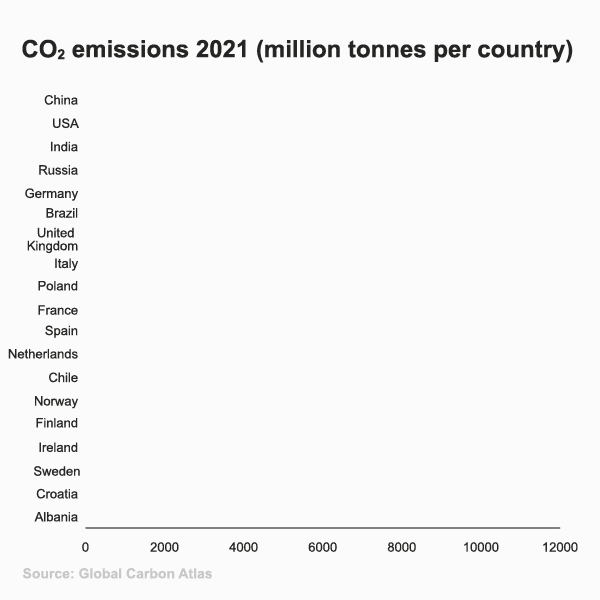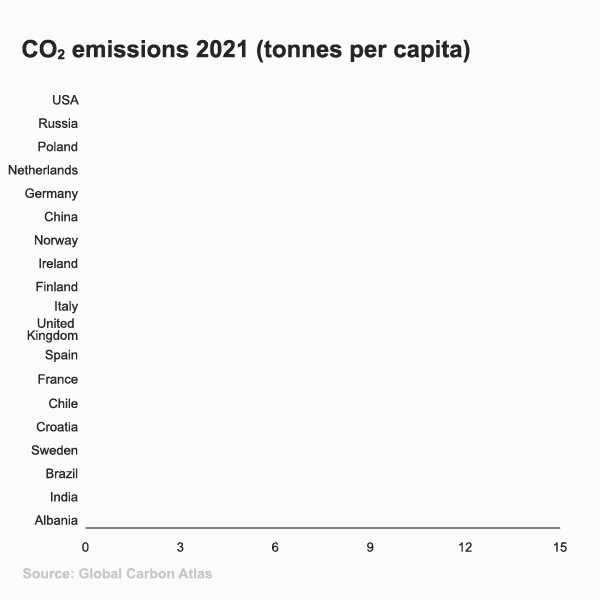
Statkraft is a part-owner of Berry Burn wind farm near the town of Inverness in the Scottish Highlands.
Country series: United Kingdom, a leader in ambition
The United Kingdom has major ambitions for cutting its greenhouse gas emissions. The goal is to become a zero-emission society by 2050. Getting there will be a taxing process and requires strong political will – and massive development of renewable power.
In the autumn of 2017, the British Government presented its Clean Growth Strategy in Parliament. The strategy sets out the Government’s ambitions for green, sustainable growth and promises to cut greenhouse gas emissions by 80 per cent compared with their level in 1990. The Government recently further raised the bar and has now determined that the goal is for the United Kingdom to become carbon-neutral by 2050.
According to figures from the Department for Business, Energy and Industrial Strategy, Britons have already reduced their emissions by 42 per cent since 1990 while achieving significant economic growth in the same period.
This has been achieved through more efficient energy use, modernisation of the country’s car fleet, better insulation of houses, more use of renewable power and replacing coal with gas. Most of these steps are, relatively speaking, "low-hanging fruit". If the new targets for 2050 are to be met, more stringent measures will have to be taken.
The staying power of fossil fuel
About half of the United Kingdom’s energy consumption is electricity-based, with more than 50 per cent of electricity currently coming from renewable sources. The transport sector and British homes on the other hand have large energy needs and continue to rely mostly on fossil fuel, specifically oil, gas and coal.
Electrical power is used for lighting, but much less so for transportation or heating. Only just over 2 per cent of the British car population is electric and most homes are heated by gas, which is also used for cooking in most places. Fortunately, the use of coal is declining rapidly. However, the only way for the United Kingdom to reach its climate targets is by also reducing its reliance on fossil fuel and gas.
Nuclear power accounts for 21 per cent of electricity generation and will continue to feature strongly in the future. Plans to develop new plants exist and if these are realised, it is likely that nuclear power will supply about one third of electricity in 2035. In addition, Britain’s renewable power requirements are set to rise in the face of electrification.

Demand for wind
"If we are to meet the 2050 emissions target, both coal and gas will need to be replaced by electricity from renewable sources. This is a complex picture; it is not just about generating enough renewable energy but also about the current infrastructure in the British Isles, which is gas-based," David Flood, the managing director of Statkraft UK says.
"Replacing this infrastructure, not to mention all gas ovens and cookers in British homes with electric cooking facilities, is a huge and very costly task. Also, millions of houses will have to be refurbished and have additional insulation put in. These are massive investments over multiple decades."
Compared to this, electrifying the car fleet can be achieved more easily. The British Government will prohibit the sale of new fossil-fuel cars on the British Isles after 2040. However, for electrification of the transport sector to be sustainable, electricity must come from renewable sources.

A wealth of wind
As anyone acquainted with the United Kingdom knows, wind is plentiful there. The British Isles already have a number of wind farms, both onshore and offshore. Statkraft has been active in power production in the United Kingdom since 2006 and the company’s portfolio currently consists of four land-based wind farms in Wales and Scotland as well as the hydropower plant at Rheidol near Aberystwyth in Wales. While the company is unlikely to invest in further hydropower developments in the United Kingdom, wind power is a priority area.
"We believe that a massive expansion of wind power is the most cost-effective technology to enable the United Kingdom to achieve its climate targets," Flood explains.
"That is why Statkraft has plans to expand its onshore wind power portfolio, not least in Scotland and Wales. The expansion will involve our own development projects, acquiring mature projects and collaborating with other players on new development projects and portfolios."
In August of 2019 Statkraft bought the company Airvolution Clean Energy Ltd., another step on the path to becoming a substantial supplier of renewable power in the United Kingdom. Current plans show that Statkraft will have 600 MW of wind power on the British Isles by 2025, and another 600 MW are on the drawing board.

The challenge of flexibility
Transitioning from fossil to renewable energy always involves one major challenge: how to store the energy being generated so that it is available when you need it? How can this flexibility be secured? Batteries are one solution; another is to use surplus energy to produce hydrogen. Fossil energy is often used to generate balancing power, but more effective use of the power grid can also enhance flexibility.
"Great Britain buys a lot of gas from Norway, but in the future Britain will want greater access to flexible and renewable power as part of a clean and secure power supply," Knut Dyrstad, who handles market regulation issues at Statkraft, says.
"This is where the planned North Sea Link to connect Norway and Scotland is very important to the United Kingdom. This link will make it possible for Britain to buy Norwegian hydropower when there is not enough wind in Scotland – and we will be able to buy British wind power when they generate a surplus. In this way Norwegian power reservoirs can offer balancing power both in Norway and the United Kingdom."
Energy consumption in the UK



Virtual power plants
In addition to being a major developer of wind power in the United Kingdom, Statkraft is an important player in the British power market. For instance, Statkraft offers independent power producers access to the market through Power Purchase Agreements (PPA). Statkraft’s solutions also enhance flexibility by allowing customers to connect to Statkraft’s virtual power plant.
"The virtual power plant is smart technology that makes it possible to manage generation from a large number of smaller power plants as if they were a single, large power plant," Dyrstad explains.
"The virtual power plant facilitates better and speedier adaptation of power generation in response to supply and demand for renewable power, and it utilises the grid’s flexibility. Combined with batteries or hydrogen energy storage, this is a good way of achieving the flexibility we will need in the coming years when we are set to increase electrification."
Sources:
world-nuclear.org: Nuclear power in the United Kingdom
gov.uk: Clean Growth Strategy
iea.org: United Kingdom 2019 Review
statkraft.co.uk

David Flood

Facts about United Kingdom
- Population: 66 million
- Capital: London
- Government: Constitutional monarchy and parliamentary democracy
- Monarch: Elisabeth II
- Prime Minister: Boris Johnson
- Official languages: English
- Regional languages: Welsh, Cornish, Scottish Gaelic, Irish
Statkraft in the UK
- Owns and operates four onshore wind farms and one hydropower plant
- Involved in the trading and origination of power from own projects and from third parties
- Has invested invested over £1.3 billion in the UK's renewable energy infrastructure since 2006
- Acquired UK onshore wind developer Airvolution Clean Energy Ltd. in 2019
- Is committed to playing a leading role in the UK energy market
- Headquarters in Moorgate in the City of London


Other country series articles

Country series: German energy revolution
2017 marked the first year when more power was produced from renewable sources than from coal in the industrial giant Germany. Nuclear power and coal power will be phased out over the next few years,...
Read more

Country series: Sweden global leader in reducing climate impact
Few countries in the world use more energy per capita than Sweden. Nevertheless, its greenhouse gas emissions are low, thanks to renewables generating a large part of the power consumed. The homeland...
Read more

Country series: Albania's hydropower important for the Balkans
Albania can play a key role when the Balkan countries phase out fossil fuels in favour of renewables. Statkraft already operates in Albania, but political risk can put a damper on further growth.
Read more

Country series: Ireland with an ambitious climate action plan
About 40 per cent of Ireland's electricity currently comes from renewable sources, but the country aims to increase this to 70 per cent by 2030.
Read more

Country series: Green ambitions in Spain
Renewable sources accounted for almost 47 per cent of the electricity produced in Spain in 2021. This is the highest share of renewable electricity since measurements began, but short of the Spanish...
Read more

Country series: Resource wealth in Brazil
Brazil is blessed with a wealth of natural resources and one of the world's cleanest power supplies. Large-scale investment in solar and wind power will provide even more renewable power in the years...
Read more

Country series: Ireland with an ambitious climate action plan
About 40 per cent of Ireland's electricity currently comes from renewable sources, but the country aims to increase this to 70 per cent by 2030.
Read more

Country series: United Kingdom, a leader in ambition
The United Kingdom has major ambitions for cutting its greenhouse gas emissions. The goal is to become a zero-emission society by 2050. Getting there will be a taxing process and requires strong poli...
Read more

Country series: Faster progress on renewables in Italy?
With its long coastline, high mountains and sunny Mediterranean islands, Italy should be well placed to increase its production of renewable energy. The challenge is to link power production with co...
Read more

Country series: The United States is still a land of opportunity
Since Statkraft opened an office in the U.S. in 2015, the company's U.S. operations have revolved largely around trading in CO2 allowances and renewable energy certificates. Statkraft is now well posi...
Read more

Country series: Renewables grow fast in Poland
Poland is one of the largest countries in Europe both in terms of energy consumption and energy production, and coal is still the main energy source. At the same time, Poland has the fastest growing...
Read more

Country series: Green visions in France
Nuclear power nation France faces massive changes in the energy sector in the years to come. An ambitious commitment to wind and solar power is one of the measures that will ensure that the climate ...
Read more

Country series: Chile leads the way with commitment to renewable energy
Chile has ambitious climate targets: 70 per cent of the country's electricity will come from renewable sources by 2030, and the country will be carbon neutral by 2050.
Read more